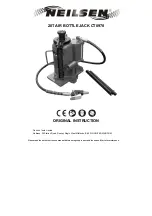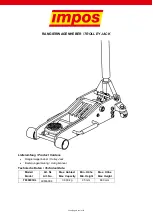
8516684
2 PC RV Scissor Jacks
V1.0
6
For technical questions call 1-800-665-8685
7.
Clamp the scissor jack’s bracket (A) to the frame with locking pliers or c-
clamps.
8. Extend the jack until it touches the ground (see Operation).
9. Check that the jack’s bracket is in the correct location.
10. Proceed to install the jack.
ATTACHING THE JACK WITH BOLTS
WARNING! Make sure that drilling at the installation location will not damage
chassis components such as electrical wiring, fuel, water or sewage lines.
Disable any active line until the installation is complete to avoid injury or
damage to the component.
1.
Mark the location and position of the jack bolt holes. A minimum of four
bolts are needed to attach each jack.
2. Retract the jack slightly and set aside.
3.
Create a dimple in each mark with a hammer and centre punch.
4.
Drill a 1/8 in. pilot hole with a suitable metal-cutting drill bit. Increase the
hole size with a 3/8 in. drill bit.
5.
Drop 3/8 in. bolts through the holes created in the rail.
6. Reposition the scissor jack and extend it, so the bolts fit through the
bracket’s holes.
7.
Screw nylon insert lock nuts onto the bolts and tighten with a ratchet
wrench.
8. Extend and retract the scissor jack to ensure it functions correctly.
ATTACHING THE JACK BY WELDING
WARNING! Take additional precautions if using an electrical welding method as
all connected metal trailer components may become electrified. Consult with
the trailer manufacturer before proceeding to ensure there are no additional
hazards due to the trailer’s material or construction.
WARNING! Welding at the installation location can damage chassis components
such as electrical wiring, fuel, water or sewage lines. Disable any active line
until the installation is complete to avoid injury or damage to the component.
1.
Consult and follow the safety and operation instructions in your welding
unit’s owner’s manual.
2. Turn the jack’s screw up to one more rotation to lock it into place with
pressure. Remove all clamps.

































